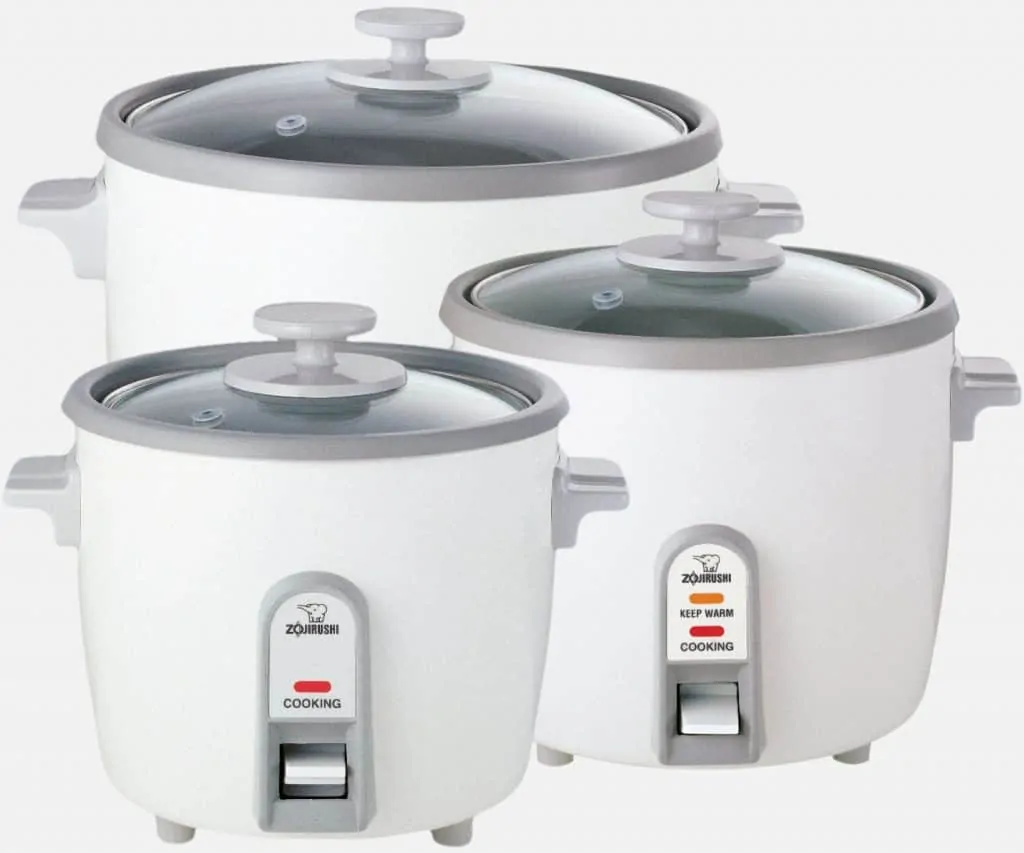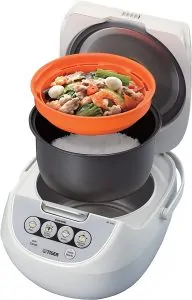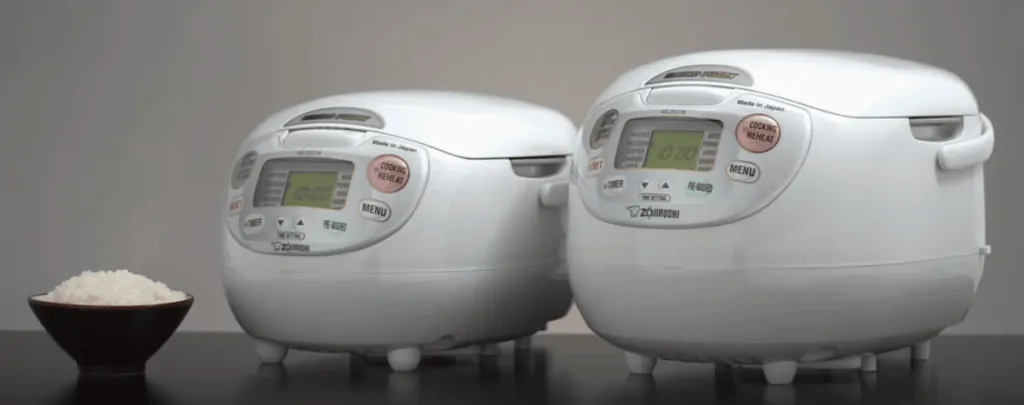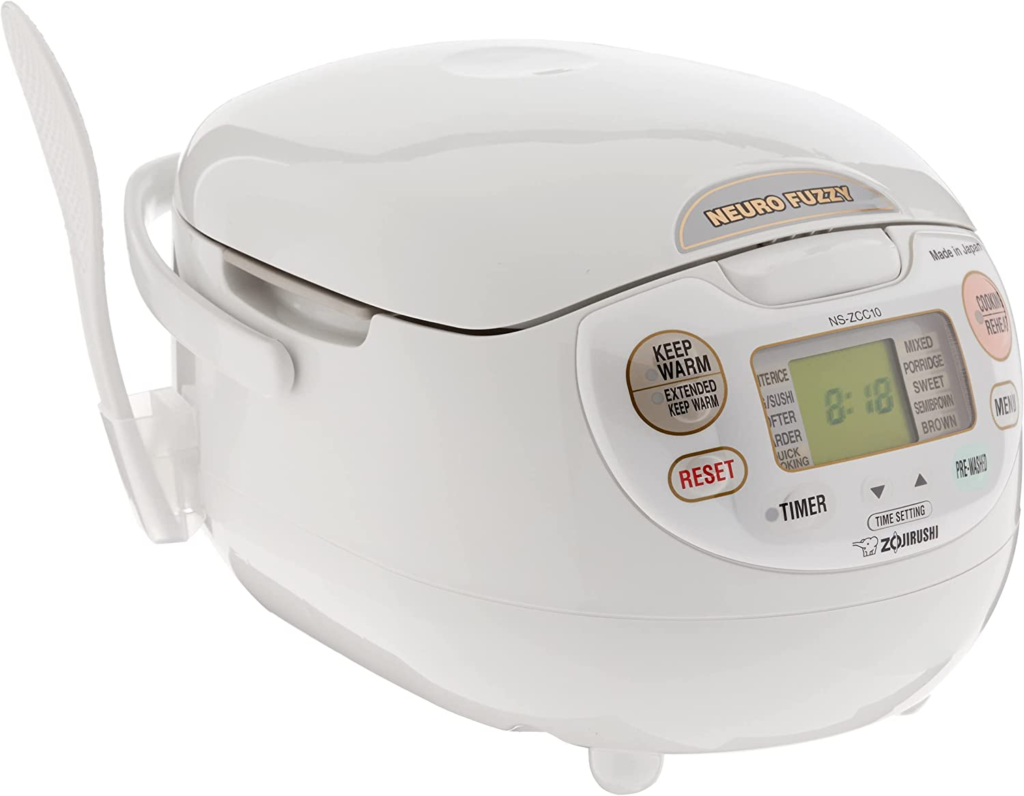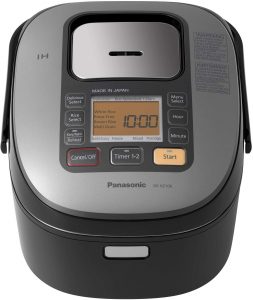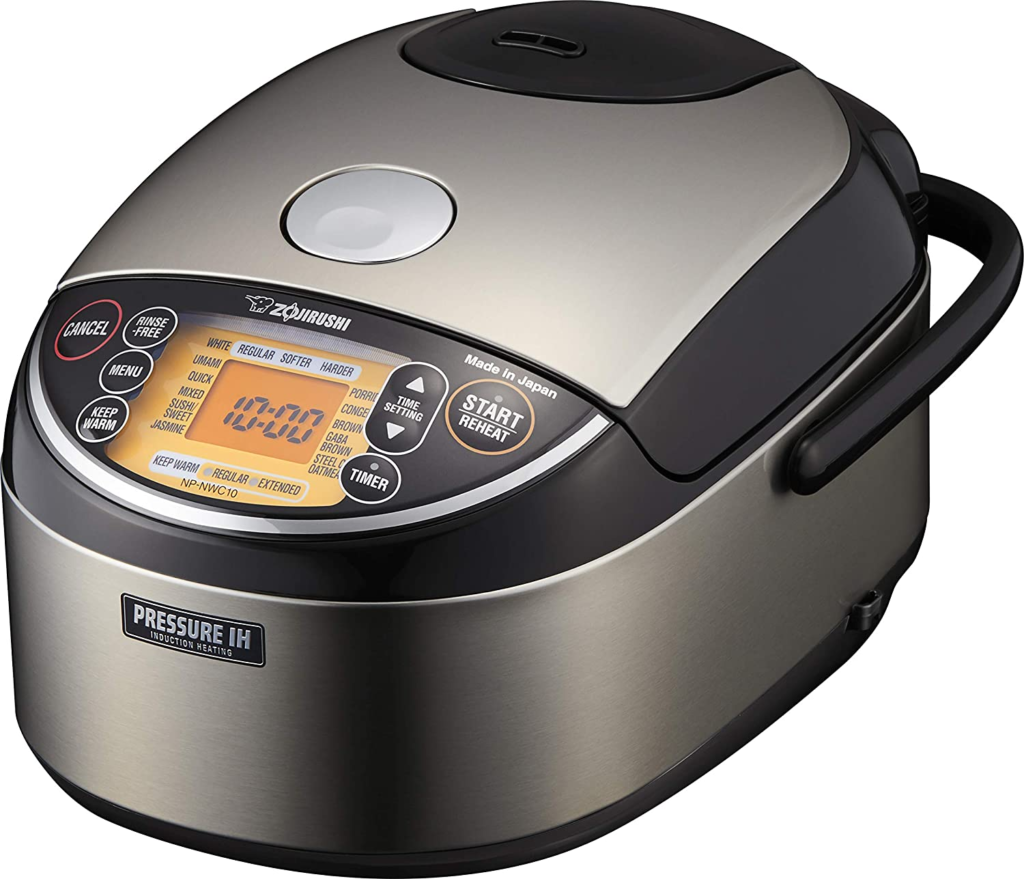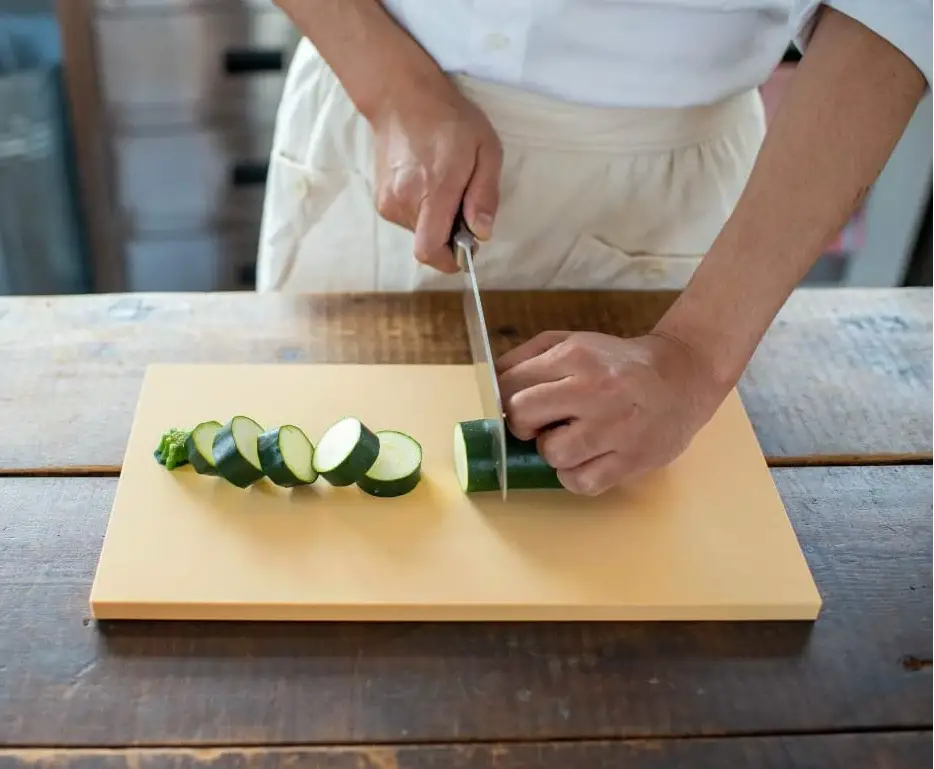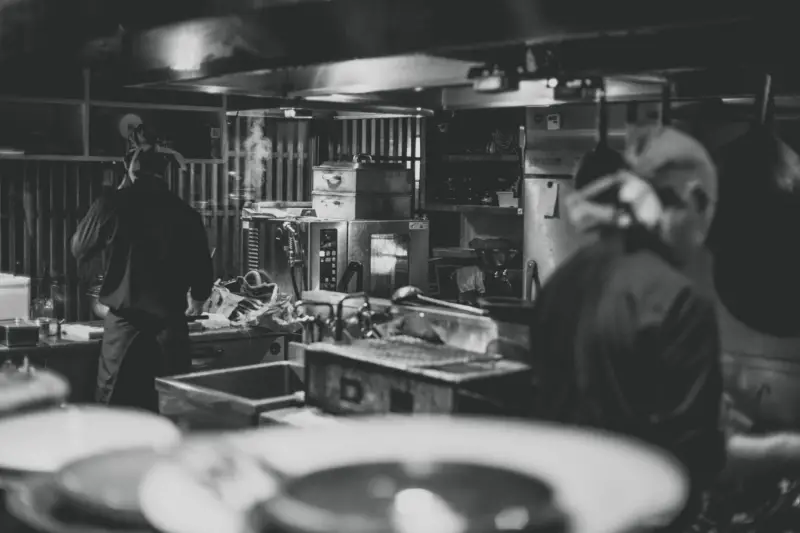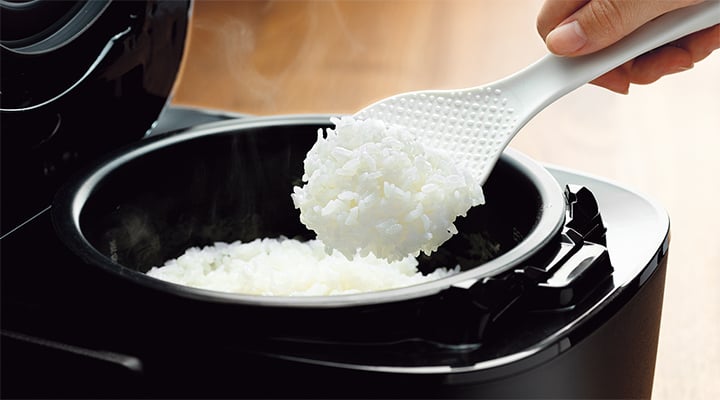
Rice! It is the most important ingredient in Japanese cuisine.
A rice cooker — or sui-hanki (炊飯器) — is thus one of the most essential Japanese cooking tools. In fact, the first electric rice cooker was invented in Japan!
In this in-depth guide, I take a look at:
- The 5 best Japanese rice cookers
- Factors to consider before buying
- Famous Japanese rice cooker brands
- Other common questions about rice cookers
Let’s get started!
The 5 Best Japanese Rice Cookers
Here are five recommendations of Japanese rice cookers to consider. I have only listed Japanese brands, and separated my picks by price level:
- Budget friendly ($50 to $100)
- Premium choices ($150 – $250)
- SUPER premium choices ($300+).
Disclaimer: The Chef Dojo may receive a small commission if you decided to purchase through some of these links. It helps to support the website. Thanks!
Budget Friendly
Here are two budget friendly options. One is a basic/conventional rice cooker, and the other is a bit more high tech (i.e. micom).
1. Zojirushi NHS-10 (3/6/10 cup)
Key Features:
- Capacity: 3, 6, or 10 cup
- Cooking System: Simple Logic / Conventional
- Inner pot: Non-stick (hand wash only)
- Settings: Keep warm system (6 or 10 cup models only)
- Accesories: Spatula, Measuring Cup and Steaming Tray
Detailed description:
Zojirushi is probably the most famous/recognized Japanese rice cooker brand in the world. They have an outstanding reputation for making super high quality, well designed products that last an extremely long time.
They are best known for their rice cookers, although they do make some other great products (breadmakers, water boilers, drink/food containers, etc).
The NHS-10 is Zojirushi’s simplest, and most budget friendly rice cooker. It uses a classic rice cooker design that has been around for many, many years.
There is just a single button (on/off). You can’t pres the wrong button even if you tried!
The rice cooker comes in three different sizes (measured in uncooked rice): 3-cup (NHS-06), 6-cup (NHS-10), or 10-cup (NHS-18).
The 6-cup and 10-cup models have a keep-warm function that automatically activates when the rice is finished cooking. The 3-cup version will simply switch off when finished cooking.
The 6-cup and 10-cup versions also come with a stainless steel steaming tray. This is super useful for steaming vegetables, eggs, fish, dumplings or whatever else you feel like while you cook the rice. The glass lid lets you easily see how your food is cooking.
The Zojirushi NHS rice cooker uses a non-stick inner pot (hand-wash only). It comes with a rice measuring cup and rice spatula/paddle (i.e. shamoji).
If you are looking for a budget-friendly, super basic Japanese rice cooker with no fancy features, then the Zojirushi NHS 06/10/18 is the best option on the market.
It is very affordable, with price ranging from around $40 – $70 (depending on size).
Note: The Zojirushi NHS model is made for the international market, and manufactured in Thailand
2. Best Budget Friendly with Micom / “Fuzzy Logic” :
Tiger JBV-A10U Micom Rice Cooker
- Great value
- Multiple cooking options
- Simple to operate
- Price (at time of publish): $80
Key Features:
- Capacity: 5.5, or 10 cup
- Cooking System: Micom / Fuzzy Logic
- Inner pot: Non-stick (hand wash only)
- Settings: Synchrony-cooking / Plain rice / Brown rice / Slow cooking; Keep-warm
- Accessories: Non-stick spatula, Cooking plate, Measuring cup and Cookbook
Detailed description:
Tiger is another well established Japanese brand that makes rice cookers as well as other consumer products. They were actually the first company to produce an IH (induction heating) rice cooker with a ceramic pot.
If you want something a bit more high-tech, but don’t want to spend over $100 on a rice cooker, then your best option is the Tiger JBV-A10U Micom (I wish companies came up with easier names for rice cookers).
It features four different cooking options — plain rice, brown rice, slow cook, and “synchro-cooking”
The synchro cooking — or “tacook” function — allows you to simultaneously cook something in the provided steaming/cooking plate at the same time you cook your rice. A useful cookbook is included to help you make use of this synchro-cooking function.
This rice cooker comes in two sizes — 5.5 cup or 10 cup. It comes with a spatula and measuring cup.
Overall, the Tiger is a great entry-level micom rice cooker. It cooks rice well, and is simple to use, but lacks a bit of features found in more expensive rice cookers like a clock/timer, and additional cooking settings.
The other main downside is that there is no sound to indicate when the rice is finished cooking (just a light).
If you want a step up from a basic rice cooker, but can’t fathom spending more than $100, then the Tiger JBV-A10U may be the best Japanese rice cooker on the market for you.
At the time of writing, the 5.5 cup version is currently on sale for just $80 (via Amazon).
Note: The Tiger JBV-A is manufactured in China
Premium
There are many great options in premium/mid-level price range ($150 – $250). It was difficult to make a choice, but I think the best premium Japanese rice cooker available is the Zojirushi NS-ZCC10/18 Neuro Fuzzy Rice Cooker:
Zojirushi NS-ZCC10 / NS-ZCC18 Neuro Fuzzy Rice Cooker
Key Features:
- Capacity: 5.5 or 10 cup
- Cooking System: Fuzzy Logic / Micom
- Inner pot: Non-stick, spherical design (for more even cooking)
- Settings: White (regular/sushi, softer/harder), mixed, porridge, sweet, semi-brown, brown, rinse-free and quick cooking; keep-warm; reheat
- Accessories: 2 measuring cups, nonstick rice spatula, rice spatula holder, and recipes
Detailed description:
This gem from Zojirushi has been one of the brand’s all-time best selling models, and for good reason.
Let’s take a further look at some of its features that helps it stand apart:
“Neuro Fuzzy” Logic System
First things first — this Zojirushi cooks perfect rice, every time. Each grain will be consistent, evenly cooked, fluffy, and delicious. This is due in large part to Zojirushi’s extremely well designed fuzzy logic system which they call “Neuro Fuzzy”.
It allows the rice cooker to automatically make fine adjustments to the temperature and cooking time according to the type of rice, amount of rice, and other custom options you may choose. And, those options are seemingly endless (white, sweet, semi-brown, brown, and rinse free). There is also an option for cooking porridge (i.e. congee).
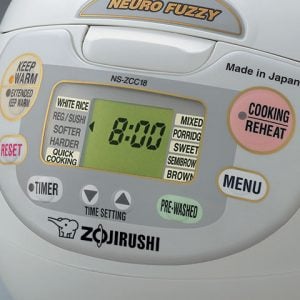
For white rice, you can even select the texture/hardness according to your taste (regular/sushi, softer, or harder).
The “quick cooking” option lets you speed up cooking time when you’re in a rush, but will result in the rice being a bit harder than normal. After pressing “cook”, the rice cooker will calculate and display how long it will take to cook the rice.
When the rice is finished cooking, the Zojiurushi will automatically switch to the “keep warm” option. It will regulate the temperature to keep the rice fresh for up to 12 hours!
There is even an “extended” keep warm option. When this is selected, the rice cooker will lower the inner temperature a bit (to approx 60°C / 140°F), which helps reduce dryness, discoloration, and smell.
Forgot when you cooked your rice? Don’t worry, the LCD panel will display exactly how long it has been since the rice has finished cooking.
When you want to eat again, you can simply select the “reheat” button. The cooker will bring the rice back up to a more suitable eating temperature. Awesome!!
Heating system + inner pot
Another feature which lets this Zojirushi cook rice better is it’s heating system. While budget rice cookers will typically only heat from the bottom of the pot , this baby heats from the bottom, around the sides, and even from the top! This helps ensure even cooking all around.
To further help cook rice evenly, the inner pot is slightly spherical compared to other rice cookers which have a more cylindrical pot. The rounder shape further promotes even cooking throughout.
The inner pot is non-stick, but also scratch resistant. This means that you can wash your rice directly in the pot without worrying about scratching it.
There are markings on the inner pot to show you the recommended water levels for cooking different types of rice (white, brown, semi-brown).
Other Details
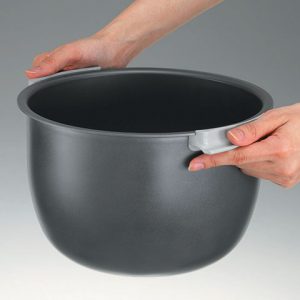
Besides cooking perfect rice, there are a ton of other small details which really make this the best premium Japanese rice cooker.
It has a timer so you can set the rice cooker to finish cooking at exactly the time you want to eat. There are even 3 different types of sounds you can choose from to notify you when the rice is finished cooking.
It is easy to clean thanks to its detachable inner lid. The inner pot has non-conductive (“stay-cool”) handles so you can easily hold the pot without burning your hands.
The power cord is retractable and there is a carry handle so you can easily store the rice cooker when it’s not in use.
This rice cooker comes with TWO measuring cups (one for normal rice), and one for rinse-free rice. It also comes with a rice paddle and paddle holder.
Made in Japan
To top things off, the NS-ZCC10 model it is actually made in Japan, so you can be extra certain that you are getting a high quality rice cooker.
If you are looking for a premium Japanese rice cooker, then you will not be disappointed with the Zojirushi NS-ZCC10/18. If you don’t believe me, you can read the 2000+ excellent reviews on Amazon (4.7/5).
It typically retails for around $200, but is on sale from time to time. Click the link below to check current prices:
Alternative premium options to consider:
Made in Japan – Zojirushi NL-AAC10
SUPER Premium Japanese Rice Cookers
$500 for a rice cooker?? Yes, sir.
Welcome to the super premium level of Japanese rice cookers. If you just want the best of the best, with the world’s latest, greatest rice cooking technology, then this section is for you.
When you’re in this price range, you really can’t go wrong as long as you pick a reputable brand. Below are a couple of SUPER premium choices for you to consider.
All of these super premium rice cookers are made in Japan.
Panasonic SR-HZ106 Induction Heating (IH) Rice Cooker
Key Features:
- Capacity: 5 cup
- Cooking System: Fuzzy Logic / Micom with Induction heating (IH)
- Inner pot material: Non-stick
- Settings: 13 cooking programs (white rice, quinoa, porridge, sticky rice, brown rice, etc.); Keep warm (up to 12 hours)
- Accesories: Steaming basket, rice scoop, cereal/soup scoop, measuring cup
Detailed description:
In Western countries, Panasonic is probably best known for making televisions and microwaves. In Japan, they are known for making some kick-ass rice cookers.
They were the first company to introduce induction heating rice cookers to the market way back in 1988.
The SR-HZ106 is one of Panasonic’s top-of-the-line offerings for the international market. It uses induction heating coils from five areas surrounding the pot — from the lid, from below the pot, and from 3 levels around the middle of the pot.
This ensures the rice is uniformly heated from all directions to produce consistent, fluffy rice.
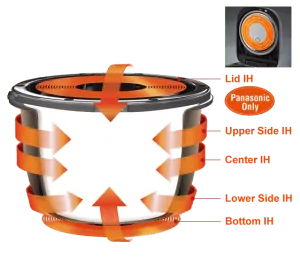
The inner pot is made of seven different layers, each with its own purpose. The most outer layer is made of copper for better heat conductivity. The pot itself is made mainly of a magnetic stainless steel, which (with the help of induction heating) transforms the entire pot itself into a heating element. This helps promote consistent heating from all angles, and more evenly cooked rice.
The inner most layer is made of a diamond ceramic material which provides a durable, non-stick surface that is also scratch resistant. This means that you can wash rice directly inside the pot without worry about damaging the coating. It also makes cleaning up a breeze.
The rice cooker features 13 (!!) different pre-set programs for a variety of different rices and other foods. This includes white rice, brown rice, sticky rice, jasmine rice, multi-grain rice, porridge, and quinoa. There is also quick cook, steam cook, slow cook/soup, and even an option for cakes/bread.

Apart from all the cooking options, the SR-HZ106 also has all the bells and whistles you would expect from a super premium rice cooker.
It has a timer so you can set when you want your rice to cook. The automatic “keep warm” option keeps rice fresh after cooking for up to 12 hours. The “reheat” button brings the rice back to the perfect eating temperature. The inner lid is easily detached, and the inner frame is made with stainless steel for super easy cleaning. The large, clear LCD screen makes it easy to see how much time is remaining, and what selections you are making.
Included with the rice cooker are two scoops (one for rice, one for porridge/soups/stews), and a measuring cup. It is only available in one size (5-cups / 1L).
Overall, the rice cooker also looks great in my opinion, and would make me jealous if I saw it in your kitchen.
As you can see, the Panasonic SR-HZ106 is much more than a simple rice cooker. It is more suitable to label it as a multi-cooker, as it can be used for such a large variety of dishes.
If you are looking to splurge on a super premium Japanese rice cooker, then you should definitely consider this Panasonic. It current retails for around $500!
Zojirushi NP-NWC10XB Induction Heating Pressure Rice Cooker
Key Features:
- Capacity: 5.5 cup
- Cooking System: Fuzzy Logic / Micom; IH; Pressurized Cooking
- Inner pot material: Non-stick
- Settings: White (regular, softer or harder), umami, mixed, sushi/sweet, Jasmine, porridge, congee, brown, GABA brown, steel cut oatmeal, rinse-free and quick cooking
- Accesories: Rice spatula, spatula holder, and 2 measuring cups (regular and rinse-free)
Detailed description:
This insance rice cooker from Zojirushi is filled with the latest technology — all in the pursuit of extra perfectly cooked rice.
It includes everything from the above mentioned NS-ZCC10 model, plus even more:
Induction Heating + Pressure Cooking
The first main unique feature is that it combines induction heating (IH) with pressure cooking. Based on the cooking option you select, the rice cooker will automatically apply one of three pressure settings. How does pressure cooking work? What is the benefit of changing the pressure?
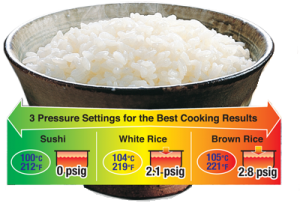
With the help of a pressure cooker, the boiling point of water can increase past the typical 100°C. It does this by trapping steam inside the pot which causes the pressure — and therefore temperature — to increase. Since the boiling point of water is higher (i.e 105°C vs 100°C), then the rice is also cooked at this higher temperature .
The increased temperature and pressure helps water and heat better penetrate the rice grains which results in more tender, soft, and fluffy rice.
This is very useful for cooking grains like brown rice which have a harder outer shell. According to Zojirushi, rice cooked under higher pressure can also stay soft for longer periods of time compared to normally cooked rice.
Fuzzy Logic + Artificial Intelligence
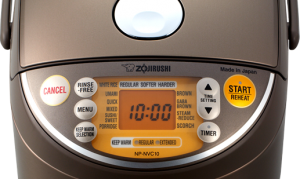
The second unique feature of this rice cooker is its fuzzy logic A.I. (Artificial Intelligence) system.
A typical fuzzy logic system will simply base the cooking process on the various options selected. This A.I. system takes it a step further.
It will actually “learn” from past cooking experiences and automatically adjust the cooking process (i.e. soaking time, steaming wait period) to produce your ideal rice (based on what you usually cook).
It even takes into consideration water/room temperature so that your rice will be the same in summer or winter. How does this work? I have no idea. It sounds amazing though.
Other than the above two technologies, there are a few other added features not found in lower end models. There is an additional cooking function for “GABA brown rice“, which is basically a more nutritious way to cook brown rice.
An “umami” setting increases soaking time and steaming time to bring more sweetness out of the rice. A “scorch” setting is available which lightly toasts the rice at the bottom of the pot to make it crispy.
Platinum inner pot
The inner pot of this rice cooker has also been further designed to increase the deliciousness of your rice. The nonstick coating on the inner layer is infused with platinum particles which makes the water become more alkaline.
Alkalized water penetrates the surface of the rice grain better, and is thus absorbed better by the rice. The result is sweeter, fuller cooked rice. The platinum coating is also more durable and resistant to scratches and peeling.
There was a ton of thought, research, and technology put into this rice cooker, and makes me think that it is worth every penny of the $500 or so it is selling for.
The only downside of this rice cooker is that it has many extra parts to clean due to the pressure cooking feature.
If you want the latest and greatest rice cooking technology, then you should consider this Zojirushi
Other super premium options to consider:
Zojirushi NP-HCC18XH
Toshiba Binchoutan Kamado Honhagama Rice Cooker
How to choose a Japanese rice cooker
Based on your budget and personal needs, there are various features to consider when buying a Japanese rice cooker. Here are some of the main ones:
- Simple or Fuzzy Logic
- Inner pot/pan material
- Heating system
- Rice cooker size
- Brand
Simple vs Fuzzy Logic (i.e. Micom)
You can choose a rice cooker with simple/basic logic, or one with fuzzy logic.
A basic rice cooker only has the ability to be on or off (or keep warm), while a fuzzy logic cooker will have a ton of other useful cooking options (rice type, reheat, timers, etc.). Higher end fuzzy logic can even adjust cooking based on temperatures and humidity.
A good fuzzy logic rice cooker will be much more expensive (usually well over $100). If you cook rice often, then it may be worth the investment.
Many fuzzy logic rice cookers are labelled as “Micom“, which stands for Micro Computerized.
Inner pot material
There are various materials that the inner pot of the rice cooker could be made of (e.g. copper, aluminum, stainless steel, ceramic). The type of material used can improve the transfer of heat, thus making your rice cooker more efficient.
For example, copper or aluminum are both highly conductive, which means they will heat up faster and improve cooking time. Stainless steel is less conductive, but more durable.
Most inner pots nowadays are coated with a non-stick material for easy cleaning/scooping. Some materials are more scratch-resistant than others.
If you are scared of toxicity from non-stick coating, then you should choose a rice cooker that has a stainless steel or ceramic pot.
Heating system – Basic vs Induction Heating (IH)

Basic rice cookers use a simple heating plate at the bottom of the rice cooker. It functions just like an electric stove.
Some advanced (and expensive) rice cookers will use something called “induction heating” (IH).
Instead of a hotplate at the bottom of the rice cooker, there are metal coils (usually made of copper) surrounding the rice cooker pot. When an alternating electric current (AC current) is passed through these coils, a magnetic field is produced. This magnetic field causes the molecules of the pot to move back and forth quickly, generating heat. The inner pot is usually also made of a variety of materials such as iron which helps make the process more efficient.
The main benefits of IH are heat control and heat distribution.
When combined with a fuzzy logic/micom system, an IH rice cooker has extreme control over the temperature. It can instantaneously change the heat level by simply strengthening or weakening the magnetic field.
IH allows for more even heat distribution. While a basic heating plate will only heat from the bottom of the pot, induction heating heats from all sides which results in more evenly cooked rice.
Rice Cooker Size
The size of rice cookers are usually measured in how many cups of raw rice it can cook. Small rice cookers are usually around 2 to 3-cups, while the largest rice cookers are 10-cups or more.
The most common rice cooker size you will find is around 5 or 6-cups, which is generally suitable for families (i.e. 3-5 people).
Additional Accessories
At minimum, make sure your rice cooker comes with a measuring cup and rice spatula/scoop. Some rice cookers come with other useful accessories like a steaming pot and spatula holder.
Best Japanese Rice Cooker Brands

The best Japanese rice cookers are — of course — made by Japanese brands.
Buying an established, reputable brand helps ensure that you will have a quality rice cooker. Some of the most famous Japanese rice cooker brands include:
- Zojirushi
- Tiger
- Panasonic
- Iris Ohyama
- Toshiba (invented the first automatic rice cooker).
It is important to note that many Japanese branded rice cookers sold to the foreign market (i.e. outside of Japan) are not actually made in Japan.
This is especially true for cheaper / budget-friendly models. They are usually made in China, Thailand or some other country with lower manufacturing costs.
Quality standards for exported versions may be a bit lower than when producing for the Japanese domestic market, but top brands should have decent quality control over their production.
If you want to be extra certain of quality, try to find a rice cooker that is actually made in Japan.
Other Japanese rice cooker FAQ
Here are some common questions you may have about Japanese rice cookers:
What is special about Japanese Rice Cookers?
Rice is an extremely important part of Japanese food and culture. Thus, rice cookers are a very important tool used in everyday lives of Japanese people.
Because of this, Japanese companies have put a lot of effort into developing rice cookers. The first rice cooker was actually invented in Japan by Toshiba. Most advancements in rice cooker technology has been made by Japanese companies (e.g. Micom cookers, induction heating, etc.). If you want the best rice cookers, Japanese brands are the place to start looking.
What is the difference between Zojirushi and Micom?
Zojirushi is a famous Japanese rice cooker brand. “Micom” simply describes a computerized logic system used in rice cookers, also known as “fuzzy logic”. Many other brands have “micom” rice cookers, not just Zojirushi.
What does Micom mean in a rice cooker?
“Micom” stands for Micro Computerized.
Do professional chefs use rice cookers?
Yes, professional chefs and restaurants use rice cookers. It is the best/only way to consistently cook a large amount of rice. Restaurants will have a much larger rice cooker than typical consumers, like this 55-cup monster.
Some higher end / small quantity restaurants may choose to cook rice in a clay pot (i.e donabe).
Summary
There you have it. That’s about everything you need to know about choosing a Japanese rice cooker.
I hope this article was also useful in helping you better understand and choose the best Japanese rice cooker for your own needs.
Which of these rice cookers would you buy?
Let me know in the comments below!
What to read next:
How do you use a rice cooker? Check out the “How to cook rice with a rice cooker” guide
Need more useful cookware? Check out the list of essential Japanese cookware.
Updated Jan. 2021: Thanks to Mr. TG for some much needed corrections
- Sources:
- https://home.howstuffworks.com/rice-cooker1.htm
- https://en.wikipedia.org/wiki/Rice_cooker
- https://web-japan.org/kidsweb/hitech/rice/rice01.html
- https://www.seriouseats.com/2020/03/how-pressure-cookers-work.html
- https://www.zojirushi.com / Platinum Rice Cooker
Subscribe for free today! Receive cool recipes, my latest Japanese knife picks and learn about Japanese culture. Delivered every other week to your inbox.
